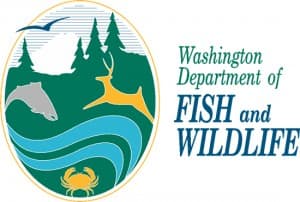Washington DFW Warns Watch Out for deer on the Roads this Fall
OutdoorHub 10.17.13

Fall is deer collision time on our roadways in Washington for a number of reasons.
Some are about deer behavior at this time of year. Deer generally move to lower elevations in the fall for easier foraging, and that’s often near human development, including roads. It’s also the rut or breeding season for deer, when bucks are less wary and all deer are moving around more.
Some are about our behavior at this time of year. Shorter days and the shift to daylight savings time put more drivers out on the roads during dimly lit hours when everything is harder to see.
Whatever the reason, the increased collision rate with deer in the fall was long ago documented by a Washington Department of Fish and Wildlife (WDFW) analysis of a Washington Department of Transportation (WSDOT) database on deer and elk carcass removal on roadways across the state. Between 2000 and 2004, a total of 14,969 deer and 415 elk carcasses were collected and recorded by date and specific milepost on Washington’s 7,046 miles of highways that receive 31.6 billion miles of travel each year.
The data confirmed some intuitive notions — deer-vehicle collisions are greatest where deer populations are most dense and where traffic is greatest. Because of those factors and others, high collision sites are clustered, not random, and WSDOT posts deer crossing signs accordingly.
The highest number of deer collisions occur during the fall and highest number of elk collisions occur during the winter. The data also confirmed:
- The majority of sites with unusually high deer-vehicle collisions were associated with posted speed limits of greater than 50 miles per hour.
- Somewhat lower collision counts were recorded on roads with more curves and vice-versa (straighter roads were associated with higher collision counts.)
- Lower collision counts were observed on eastern Washington rural interstate highways, eastern Washington urban principal arterials, and western Washington urban minor arterials -at least compared to other roadway classifications.
Comparing the WSDOT data with established landscape databases revealed a few more patterns, including:
- Cover, forage, and water available near roads were generally associated with higher collision counts in eastern Washington mule and white-tailed deer habitat.
- Southern aspects (south-facing roadside slopes) were generally associated with higher collision counts in western Washington rural areas.
- Lower collision counts were associated more with steep roadside slopes (more than 35 degrees) than with moderate slopes (less than 35 degrees).
So what can be done to avoid crossing paths with deer in such a traumatic way?
For the driver, slowing down during fall and winter is the first step, especially in the hours just before, during, and after dusk and dawn. Paying attention to WSDOT’s deer crossing signs, and particularly “high kill area” signs, can be critical. Speed limit reductions at night along stretches of highway with a high rate of collisions might be in order.
In general, new highway development in high deer or elk use areas should be avoided.
Deer or elk could be protected from collisions with construction of fences along roadways with high collision rates, especially if combined with existing bridges or development of over or under passes to allow natural movement. Such efforts have proved effective in other parts of the country.
WSDOT has wildlife crossing projects underway, such as the Snoqualmie Pass East section of Interstate 90 which will have three miles of the five-mile project completed by the end of this month. (For more information see www.wsdot.wa.gov/Projects/I90/SnoqualmiePassEast/HyaktoKeechelusDam/ ).
Not all collisions with wildlife become roadkill. If you hit and injure a deer or other wild animal, or find an injured wild animal on the roadside, you can call a trained wildlife rehabilitator who might be able to safely retrieve the animal and care for it. (See http://wdfw.wa.gov/conservation/health/rehabilitation/how_to_find.html .)

